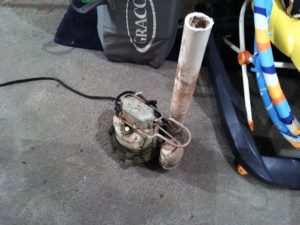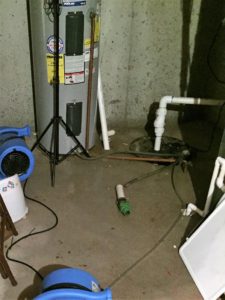Understanding Basement Construction
As a water damage restoration contractor our view point on basements, is not if but when they’ll will flood…
In central Indiana, we find ourselves standing in a lot of flooded basements.
Many times it is unavoidable, which is why a homeowner needs to have the proper insurance coverage for their basement.
How the Basement is Built
Basements are built deep into the ground and because they are built deep into the ground, they fight against water intrusion constantly. It is essentially like building a concrete boat which is typically not a good idea.
The foundation walls are concrete, which is not a waterproof building product. This is why a waterproofing system is installed on the outside of the wall, when the house it first built. The waterproofing membrane can be a peel and stick product or a liquid based product that is sprayed or rolled on the wall.
The contractor gets one chance to do this correctly. It is very hard and costly to dig up the dirt around the basement foundation walls to re-apply or fix the basement waterproofing if it goes bad.
The waterproofing membrane helps keep the water from coming into the basement, but it doesn’t pump the water away from the walls. This is why sump pump systems are installed.
Basement Waterproofing Solutions
Sump Pump System
A sump pump system is a combination of drain pipes that are installed at the bottom of the basement foundation walls, a sump pit and a pump.
The excess water that is exerting pressure on the basement walls after a heavy rain or snow melt needs to be pumped away so that the walls are not damaged because of the weight or pressure of the water.
In theory, a sump pump system is good because it helps maintain good foundation walls by removing the water pressure. The bad side of the system is that it relies entirely on one mechanical pump.
Sump pumps typically need to be changed every 3 – 5 years. The problem is most homeowners don’t know when the last pump was installed. The safest thing a homeowner can do is install a brand new sump pump and make sure it sized and installed by a licensed plumber.
If the sump pump is undersized, it will not be able to pump the water fast enough and the water will back up into the basement.

Sump Pump

Basement Sump Pump
Sump Pump Battery Backup
In our opinion these systems are not worth the money. Number one reason we don’t recommend them because we are cleaning up a lot of flooded basements that have them installed.
Now from a technical standpoint, these systems are usually installed with a 12 Volt Lead Acid Battery, that operate a smaller pump than your traditional sump pump. These systems are installed just in case you lose power during a large storm.
Typically, during a large storm your basement is fighting against more water than normal and you need all the pump capacity that you can get. Well when the power is out, your sump pump battery backup system kicks on, but it is only able pump water using the smaller pump that is installed with the battery backup. If the power is out too long more than likely the pump will not be able to keep up with the volume of water.
The other limiting factor of the system is the 12 volt lead acid battery only has so much power to give. If the power is shut down for longer than a few hours you might start having water backing up into the basement because your battery is out of electricity to power the pump.
Backup Generator for Sump Pump
The best way to avoid a flooded basement during a large storm is to use a backup generator to run the sump pump. If you have a small 2500 to 3000 watt gas powered generator on standby, this should be enough to keep your pump running, until the utility power is turned back on.
Dehumidification
Dehumidifier for Basement
All basements should have a small dehumidifier running to keep the humidity down. Basements are generally cooler than the other areas of the home. Which means they are susceptible to condensation moisture and mold growth because of that moisture.
When the humidity is high and the surfaces of your basement walls and floor are cool, the moisture can fall out of the air and absorb into your building materials (drywall, wood, carpet etc.). When this happens the excess moisture, organic materials, and no sunlight is a good breeding ground for mold.
Best Dehumidifier for Basement
Our recommendation is to buy a dehumidifier that has an automatic pump system.
The auto pump feature allows the water created from the dehumidifier to be pumped into a drain without the homeowner being involved.
A small, inexpensive dehumidifier, we recommend to our customers is a Soleus Air® 70-Pint Dehumidifier with Internal Pump. This is a good size dehumidifier that has an internal pump so you don’t have to empty the drain pan or manual operate the pump.
Basement Finishing Options
Finished basements usually take the form of wood walls, that are insulated with R-19 Batt insulation, covered with paper faced drywall, with wood baseboards installed between the concrete slab and the drywall and carpet and pad flooring.
Other amenities that can be installed are full bathrooms with sink, toilet and a shower. A partial or full kitchen installed with a sink, dishwasher and refrigerator. Or large TV rooms or theaters rooms for the family to enjoy movie night.
All of these amenities come with their difficulties if your basement floods.
Basement Flooring
We have seen many people install many different flooring products in basements. There are a few products we recommend but a lot that do not work well in a basement.
Do not install any wood based flooring products in a basement. This includes hardwoods, engineered hardwood, wood based laminate or any variation of these floorings.
Wood and water damage do not mix well. Basements are very prone to water damage. Therefore it does not make sense to install wood based flooring products in a basement.
Caret is affordable, compared to other flooring options but carpet and pad also absorb a lot of water when affected by water damage. Usually a homeowner will need to hire a water restoration contractor if their basement floods and they have carpet installed.
Next we will talk about different waterproof and water resistant flooring.
Waterproof Flooring or Water Resistant
The only flooring that is technically waterproof in our opinion is concrete and ceramic or stone based tiles. These products when installed on a concrete slab do not need to be removed when a basement floods.
Vinyl Laminate Plank or Waterproof Laminate Floors do need to be removed when a basement floods. Therefore, in our opinion these floors are not waterproof but water resistant.
They are great products to install in a basement when considering flooring options. But they should be removed if you experience a flooded basement. Read more about waterproof laminate flooring.
Basement Bathrooms
If are finishing a basement with a fully functioning bathroom, this will require a trash pump system to be installed. This trash pump is what takes the “sewage water” from your sinks and toilets up to the sewer system.
Much like a sump pump, the trash pump runs on electricity and has a limited life span. If the trash pump fails or backs up, you not only have water damage but you have sewage damage.
The standard operating procedure for a sewage cleanup is to remove all porous materials that the water touches. This includes drywall, baseboards, insulation and carpeting.
Most people who have bathrooms in their basements, don’t know they own a trash pump until it needs replaced. These pumps don’t have to work has hard as the sump pump, but they do require oversight to make sure they are being changed within their lifespan.
